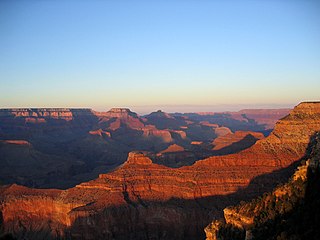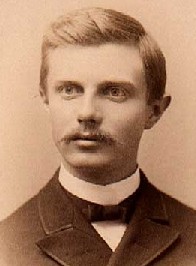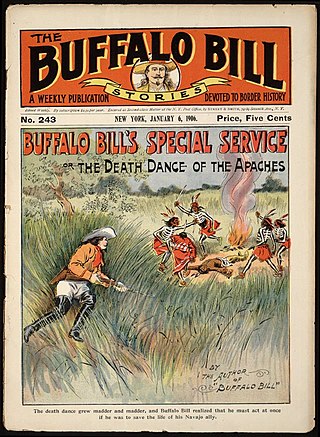
The Great Plains, sometimes simply "the Plains", is a broad expanse of flatland in North America. It is located just to the east of the Rocky Mountains, much of it covered in prairie, steppe, and grassland. It is the western part of the Interior Plains, which also include the mixed grass prairie, the tallgrass prairie between the Great Lakes and Appalachian Plateau, and the Taiga Plains and Boreal Plains ecozones in Northern Canada. Great Plains or Western Plains is also used to describe the ecoregion of the Great Plains, or alternatively the western portion of the Great Plains.

The Southwestern United States, also known as the American Southwest or simply the Southwest, is a geographic and cultural region of the United States that includes Arizona and New Mexico, along with adjacent portions of California, Colorado, Nevada, Oklahoma, Texas, and Utah. The largest cities by metropolitan area are Phoenix, Las Vegas, El Paso, Albuquerque, and Tucson. Before 1848, in the historical region of Santa Fe de Nuevo México as well as parts of Alta California and Coahuila y Tejas, settlement was almost non-existent outside of Nuevo México's Pueblos and Spanish or Mexican municipalities. Much of the area had been a part of New Spain and Mexico until the United States acquired the area through the Treaty of Guadalupe Hidalgo in 1848 and the smaller Gadsden Purchase in 1854.

The Western United States is the region comprising the westernmost U.S. states. As American settlement in the U.S. expanded westward, the meaning of the term the West changed. Before around 1800, the crest of the Appalachian Mountains was seen as the western frontier. The frontier moved westward and eventually the lands west of the Mississippi River were considered the West.

Frederick Jackson Turner was an American historian during the early 20th century, based at the University of Wisconsin-Madison until 1910, and then Harvard University. He was known primarily for his frontier thesis. He trained many PhDs who went on to become well-known historians. He promoted interdisciplinary and quantitative methods, often with an emphasis on the Midwestern United States.

The American frontier, also known as the Old West, and popularly known as the Wild West, encompasses the geography, history, folklore, and culture associated with the forward wave of American expansion in mainland North America that began with European colonial settlements in the early 17th century and ended with the admission of the last few contiguous western territories as states in 1912. This era of massive migration and settlement was particularly encouraged by President Thomas Jefferson following the Louisiana Purchase, giving rise to the expansionist attitude known as "manifest destiny" and historians' "Frontier Thesis". The legends, historical events and folklore of the American frontier have embedded themselves into United States culture so much so that the Old West, and the Western genre of media specifically, has become one of the defining features of American national identity.
The Frontier Thesis, also known as Turner's Thesis or American frontierism, is the argument advanced by historian Frederick Jackson Turner in 1893 that the settlement and colonization of the rugged American frontier was decisive in forming the culture of American democracy and distinguishing it from European nations. He stressed the process of "winning a wilderness" to extend the frontier line further for U.S. colonization, and the impact this had on pioneer culture and character. Turner's text takes the ideas behind Manifest Destiny and uses them to explain how American culture came to be. The features of this unique American culture included democracy, egalitarianism, uninterest in bourgeois or high culture, and an ever-present potential for violence. "American democracy was born of no theorist's dream; it was not carried in the Susan Constant to Virginia, nor in the Mayflower to Plymouth. It came out of the American forest, and it gained new strength each time it touched a new frontier," wrote Turner.

Western fiction is a genre of literature set in the American Old West frontier and typically set from the late eighteenth to the late nineteenth century. Well-known writers of Western fiction include Zane Grey from the early 20th century and Louis L'Amour from the mid-20th century. The genre peaked around the early 1960s, largely due to the popularity of televised Westerns such as Bonanza. Readership began to drop off in the mid- to late 1970s and reached a new low in the 2000s. Most bookstores, outside a few west American states, only carry a small number of Western fiction books.

Environmental history is the study of human interaction with the natural world over time, emphasising the active role nature plays in influencing human affairs and vice versa.

Cattle drives were a major economic activity in the 19th and early 20th century American West, particularly between 1850s and 1910s. In this period, 27 million cattle were driven from Texas to railheads in Kansas, for shipment to stockyards in St. Louis and points east, and direct to Chicago. The long distances covered, the need for periodic rests by riders and animals, and the establishment of railheads led to the development of "cow towns" across the frontier.

This timeline of the American Old West is a chronologically ordered list of events significant to the development of the American West as a region of the continental United States. The term "American Old West" refers to a vast geographical area and lengthy time period of imprecise boundaries, and historians' definitions vary. The events in this timeline occurred primarily in the portion of the modern continental United States west of the Mississippi River, and mostly in the period between the Louisiana Purchase in 1803 and the admission of the last western territories as states in 1912 where most of the frontier was already settled and became urbanized; a few typical frontier episodes happened after that, such as the admission of Alaska into the Union in 1959. A brief section summarizing early exploration and settlement prior to 1803 is included to provide a foundation for later developments. Rarely, events significant to the history of the West but which occurred within the modern boundaries of Canada and Mexico are included as well.

The frontier myth or myth of the West is one of the influential myths in American culture. The frontier is the concept of a place that exists at the edge of a civilization, particularly during a period of expansion. The American frontier occurred throughout the 17th to 20th centuries as European Americans colonized and expanded across North America. This period of time became romanticized and idealized in literature and art to form a myth. Richard Slotkin, a prominent scholar on the subject, defines the myth of the frontier as "America as a wide-open land of unlimited opportunity for the strong, ambitious, self-reliant individual to thrust his way to the top."

Al Sieber was a German-American who fought in the U.S Civil War and in the American Old West against Indians. He became a prospector and later served as a Chief of Scouts during the Apache Wars.
The "new western history" movement emerged among professional historians in the 1980s, a belated manifestation of the 1970s "new social history" movement. The new western historians recast the study of American frontier history by focusing on race, class, gender, and environment in the trans-Mississippi West. The movement is best known through the work of Patricia Nelson Limerick, Richard White, William Cronon, and Donald Worster. The philosophy and historiography of the new western historians is discussed thoroughly and supportively in Patricia Nelson Limerick, Clyde Milner II, and Charles E. Rankin, eds., Trails: Toward A New Western History. An overview of the New Western History is available in Clyde Milner, et al., The Oxford History of the American West. The movement has been thoroughly critiqued by historian Michael Allen.

The following works deal with the cultural, political, economic, military, biographical and geologic history of pre-territorial Montana, Montana Territory and the State of Montana.

For a useful starting point goto Oregon Encyclopedia of History and Culture (2022). Not yet in print format; it is online here with 2000 articles.
Hal K. Rothman (1958–2007) was a historian, professor, radio show host, editor, public intellectual, and prolific author. Noted environmental history scholar Char Miller called him "a dynamic teacher, riveting speaker, compelling scholar, and sharp-tongued pundit." The writer Will Sarvis called Rothman "one of the best editors" he had ever worked with. University of Colorado historian Patricia Nelson Limerick described Rothman as a key contributor in the late 20th century renaissance of American West history. Limerick confirmed Rothman's almost unworldly level of energy, "Especially [in] the rate of publications -- thoughtful, and really worthwhile books." Rothman made numerous national media appearances in the New York Times, Wall Street Journal, Chicago Tribune, and on CNN, ABC, CBS, NBC, and other places. He was inducted into the Nevada Writers Hall of Fame in 2004.
This is a Mexican American bibliography. This list consists of books, and journal articles, about Mexican Americans, Chicanos, and their history and culture. The list includes works of literature whose subject matter is significantly about Mexican Americans and the Chicano/a experience. This list does not include works by Mexican American writers which do not address the topic, such as science texts by Mexican American writers.
The following works deal with the cultural, political, economic, military, biographical and geologic history of the Midwestern United States.
This is an English language bibliography of scholarly books and articles on the American frontier. It is a selection from tens o thousands of titles. See also: Bibliography of the Western United States












